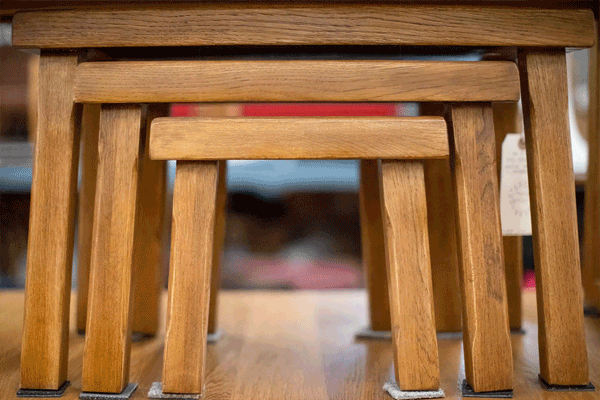FURNISHINGS : Polishing Up Old Wood Pieces Brings History to Life
- Share via
Furniture whose past can be read in its scars and blemishes is in vogue, so try polishing up a piece from the garage or secondhand store.
No special skill is needed to remove the grime. Apply a good quality furniture cream and rub, says John Johnson, a woodworker whose retail business, the Woodworkers Store in Norwalk, Conn., caters to hobbyists.
“The next step beyond pure amateur is easier than many people think,” he says, “because there are new products on the market, and a great deal of help is available.”
A do-it-yourselfer can go into a specialty store such as his and see a variety of finishes--lacquer, wax, oil, color stains, flat and shiny varnish.
“The most desirable old wood furniture has the original finish, even if it’s faded or unevenly worn, so don’t wipe out history by stripping furniture chemically,” he advises. “Many times you don’t have to strip down to bare wood to improve the looks of an old piece.”
New products specifically for amateurs include spray-on paints that create special effects. Plasti-Kote Co. Inc. of Medina, Ohio, for example, has a faux stone finish in 12 colors and a crackle glaze in six colors. The stone look can go over just about anything--wood, metal, wicker and plastic. But the crackle finish must be tested first because it can lift some finishes. A color wash in six shades can be brushed onto unfinished or stripped wood.
“People do chairs, tables and cabinet fronts, but also refrigerators, bath fixtures, picture frames, file cabinets, lamps,” says Judy Vorthman, merchandise coordinator of Plasti-Kote. “Most people are redoing ‘attic’ finds, but they’re also doing kitchen cabinets, bathrooms and fireplaces.”
Easy-to-use products are now sold by a number of companies through a variety of retailers--mass merchandisers, home centers and large crafts stores.
Since refinishing is new to many people, the companies are trying to get the consumers’ attention with in-store videos and promotional literature. Plasti-Kote, for example, has a demonstration video available to stores.
“With refinishing, one picture is worth a thousand words,” Johnson says. He stocks videos and schedules seminars one Saturday a month.
Another spur to redoing furniture at home is that products, such as those made by Behlen’s, once available only to professionals, are now marketed to do-it-yourselfers.
“Our mind-set is professional products that an amateur can use,” says Jonathan Kemp, national sales manager of H. Behlen & Bros., of Amsterdam, N.Y. The company, which has been making professional finishing products since 1888, is now packaging smaller sizes for the hobbyist.
“We used to sell products in gallon sizes only; now we market quarts and pints,” Kemp says.
To aid consumers, Behlen added information to product labels, published point-of-sale literature and began in-store demonstrations. Kemp, for example, spoke about finishing products at Johnson’s store in January.
“Instead of playing golf, professionals and managerial types are going to the next level . . . and becoming more serious about their woodworking projects--even buying woodworking machinery and exotic woods,” Kemp says.
But for the times when doing it yourself just won’t do, look for a professional.
Wood furniture, no matter how disreputable-looking, can be put into surprisingly good shape via expert stripping, repairing and refinishing, says John Dotson, a furniture refinisher in Wilton, Conn. He estimates a small chest in bad shape might cost up to $300 to redo, a dining chair about $125.
“Compared to the cost of buying a new piece,” he says, “repairs are often a bargain.”
Dotson says the best way to find a good refinisher is to shop around.
“Get personal references, compare prices and insist on looking at some finished work by the person in question,” he says.


